Analyzing Carbon Emission: Environmental Performance and Disclosure
VerifiedAdded on 2023/06/15
|6
|1630
|379
Report
AI Summary
This report investigates the relationship between companies' use of internal carbon pricing and their environmental performance, specifically focusing on carbon emission disclosures. Utilizing a sample of 74 organizations, the research employs a matched sample test to analyze the impact of internal carbon pricing on carbon disclosure scores, considering the legitimacy theory. The findings suggest a significant connection between these factors, indicating that companies' internal carbon pricing strategies influence their disclosure practices. The research highlights the importance of transparency in carbon emissions for attracting investors and managing risks, while also acknowledging limitations such as sample size and the focus on a single theory. Further research is recommended to explore other relevant theories like stakeholder and agency theory, and to broaden the scope of the investigation across different sectors and time periods. Desklib provides access to this report and many other solved assignments.
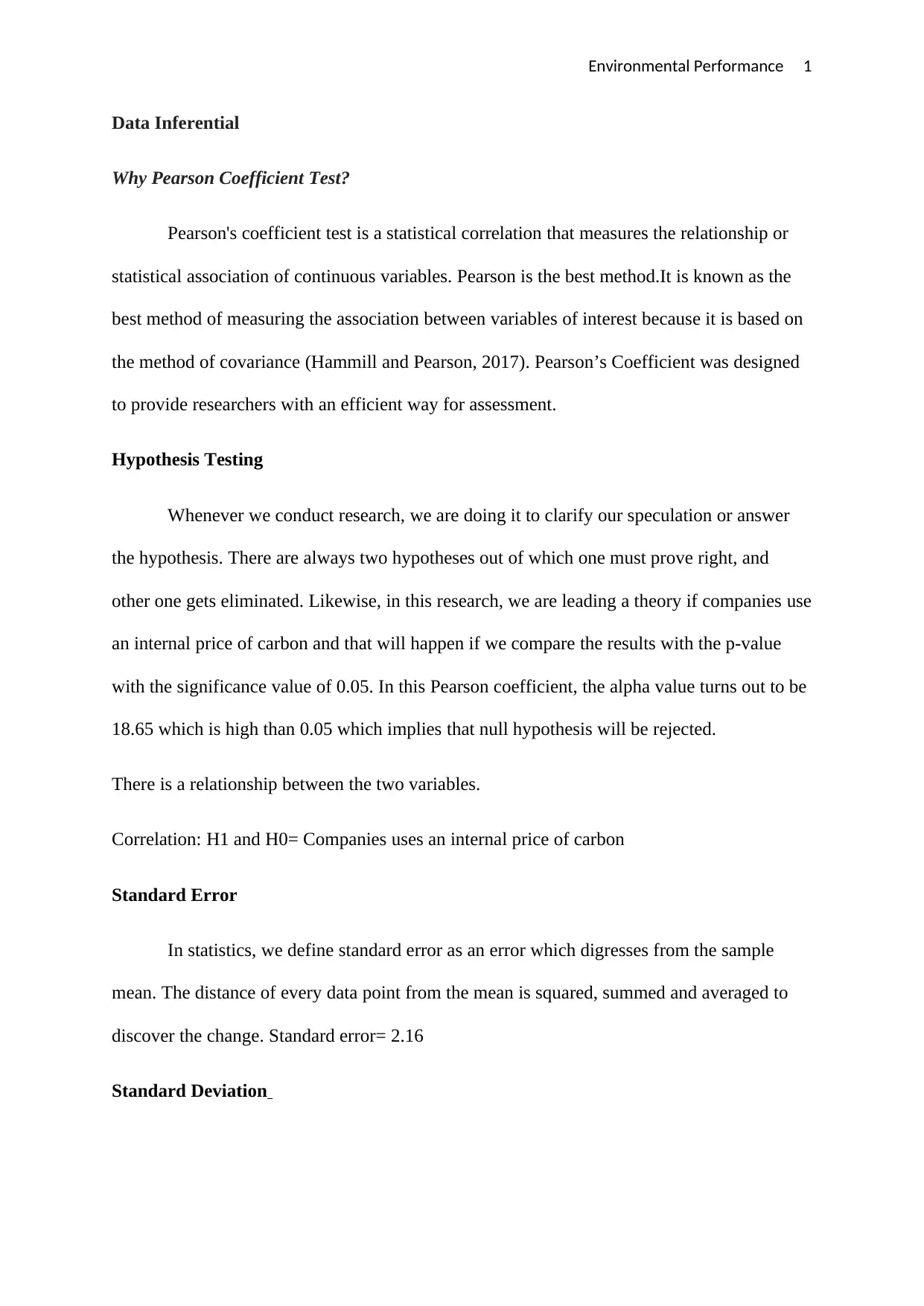
Environmental Performance 1
Data Inferential
Why Pearson Coefficient Test?
Pearson's coefficient test is a statistical correlation that measures the relationship or
statistical association of continuous variables. Pearson is the best method.It is known as the
best method of measuring the association between variables of interest because it is based on
the method of covariance (Hammill and Pearson, 2017). Pearson’s Coefficient was designed
to provide researchers with an efficient way for assessment.
Hypothesis Testing
Whenever we conduct research, we are doing it to clarify our speculation or answer
the hypothesis. There are always two hypotheses out of which one must prove right, and
other one gets eliminated. Likewise, in this research, we are leading a theory if companies use
an internal price of carbon and that will happen if we compare the results with the p-value
with the significance value of 0.05. In this Pearson coefficient, the alpha value turns out to be
18.65 which is high than 0.05 which implies that null hypothesis will be rejected.
There is a relationship between the two variables.
Correlation: H1 and H0= Companies uses an internal price of carbon
Standard Error
In statistics, we define standard error as an error which digresses from the sample
mean. The distance of every data point from the mean is squared, summed and averaged to
discover the change. Standard error= 2.16
Standard Deviation
Data Inferential
Why Pearson Coefficient Test?
Pearson's coefficient test is a statistical correlation that measures the relationship or
statistical association of continuous variables. Pearson is the best method.It is known as the
best method of measuring the association between variables of interest because it is based on
the method of covariance (Hammill and Pearson, 2017). Pearson’s Coefficient was designed
to provide researchers with an efficient way for assessment.
Hypothesis Testing
Whenever we conduct research, we are doing it to clarify our speculation or answer
the hypothesis. There are always two hypotheses out of which one must prove right, and
other one gets eliminated. Likewise, in this research, we are leading a theory if companies use
an internal price of carbon and that will happen if we compare the results with the p-value
with the significance value of 0.05. In this Pearson coefficient, the alpha value turns out to be
18.65 which is high than 0.05 which implies that null hypothesis will be rejected.
There is a relationship between the two variables.
Correlation: H1 and H0= Companies uses an internal price of carbon
Standard Error
In statistics, we define standard error as an error which digresses from the sample
mean. The distance of every data point from the mean is squared, summed and averaged to
discover the change. Standard error= 2.16
Standard Deviation
Paraphrase This Document
Need a fresh take? Get an instant paraphrase of this document with our AI Paraphraser

Environmental Performance 2
Standard deviation is the deviation of the information from its actual mean. It is
calculated on the mean. It can get influenced by the extreme high or low values in the data.
The difference of every data value from the mean is first squared, summed and after that
averaged to discover the deviation. On the off chance that the information point is far from
the mean, the higher is the standard deviation. In this paired sample test, the standard
deviation turns out to be SD = ±18.65, which is high and states that the disclosure scores are
far away (in any event roughly 59%) from the normal esteem.
Discussion
The research project has been done on the subject of whether companies use an
internal price of carbon from a legal perspective of the legitimate theory. It was an incredibly
fascinating and vital subject of discussion about because carbon emanation is turning into a
worldwide issue (Andrew and Cortese, 2011). The convergence of carbon has been
expanding after some time and is turning into a matter of concern. At the overall scale, rates
of soil CO2 efflux relate out and out with temperature and precipitation; they do not connect
well with soil carbon pools, soil nitrogen pools, or soil. Wetlands cover around 3% of the
land zone, however, diminish foreseen CO2 surges by just around 1% (Raich and Potter,
1995). Numerous huge ventures are contributing towards it consistently, and in this
undertaking, we will assess how their commitments are influencing this carbon changes. The
dependent variable was disclosure of internal carbon pricing, and the independent variable
was carbon emission. Control variable was administration quality. The theory was to assess if
the companies use an internal carbon pricing and do that impact carbon disclosure scores. In
this research, we had taken 74 organisations information and analyse their reactions in yes or
no towards our examination question. We had taken combined example test as 37
organisations reaction was yes, and rest 37 organisations reaction was no. Both independent
and control factors are inspected. Matched example test was directed because we had two
Standard deviation is the deviation of the information from its actual mean. It is
calculated on the mean. It can get influenced by the extreme high or low values in the data.
The difference of every data value from the mean is first squared, summed and after that
averaged to discover the deviation. On the off chance that the information point is far from
the mean, the higher is the standard deviation. In this paired sample test, the standard
deviation turns out to be SD = ±18.65, which is high and states that the disclosure scores are
far away (in any event roughly 59%) from the normal esteem.
Discussion
The research project has been done on the subject of whether companies use an
internal price of carbon from a legal perspective of the legitimate theory. It was an incredibly
fascinating and vital subject of discussion about because carbon emanation is turning into a
worldwide issue (Andrew and Cortese, 2011). The convergence of carbon has been
expanding after some time and is turning into a matter of concern. At the overall scale, rates
of soil CO2 efflux relate out and out with temperature and precipitation; they do not connect
well with soil carbon pools, soil nitrogen pools, or soil. Wetlands cover around 3% of the
land zone, however, diminish foreseen CO2 surges by just around 1% (Raich and Potter,
1995). Numerous huge ventures are contributing towards it consistently, and in this
undertaking, we will assess how their commitments are influencing this carbon changes. The
dependent variable was disclosure of internal carbon pricing, and the independent variable
was carbon emission. Control variable was administration quality. The theory was to assess if
the companies use an internal carbon pricing and do that impact carbon disclosure scores. In
this research, we had taken 74 organisations information and analyse their reactions in yes or
no towards our examination question. We had taken combined example test as 37
organisations reaction was yes, and rest 37 organisations reaction was no. Both independent
and control factors are inspected. Matched example test was directed because we had two
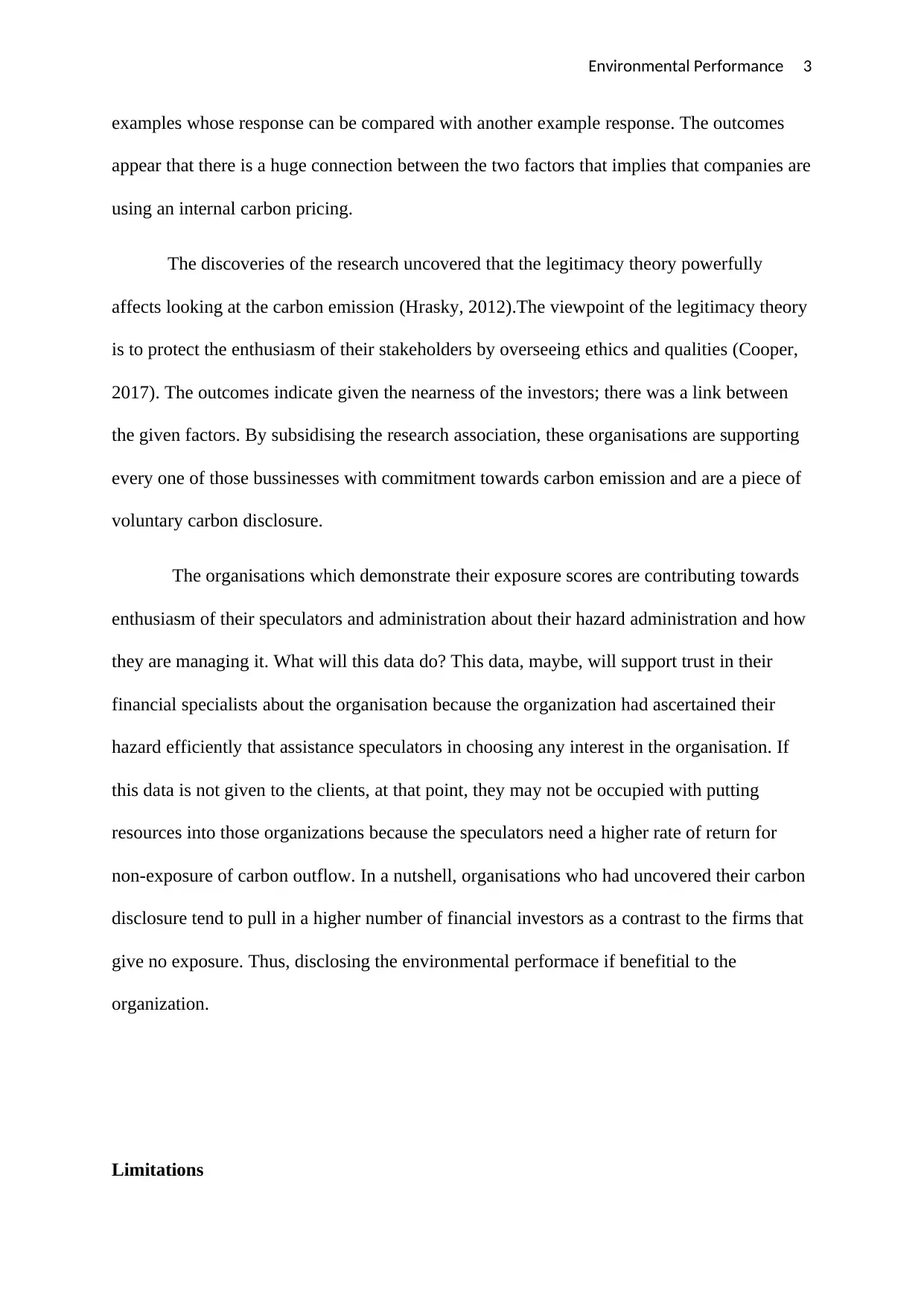
Environmental Performance 3
examples whose response can be compared with another example response. The outcomes
appear that there is a huge connection between the two factors that implies that companies are
using an internal carbon pricing.
The discoveries of the research uncovered that the legitimacy theory powerfully
affects looking at the carbon emission (Hrasky, 2012).The viewpoint of the legitimacy theory
is to protect the enthusiasm of their stakeholders by overseeing ethics and qualities (Cooper,
2017). The outcomes indicate given the nearness of the investors; there was a link between
the given factors. By subsidising the research association, these organisations are supporting
every one of those bussinesses with commitment towards carbon emission and are a piece of
voluntary carbon disclosure.
The organisations which demonstrate their exposure scores are contributing towards
enthusiasm of their speculators and administration about their hazard administration and how
they are managing it. What will this data do? This data, maybe, will support trust in their
financial specialists about the organisation because the organization had ascertained their
hazard efficiently that assistance speculators in choosing any interest in the organisation. If
this data is not given to the clients, at that point, they may not be occupied with putting
resources into those organizations because the speculators need a higher rate of return for
non-exposure of carbon outflow. In a nutshell, organisations who had uncovered their carbon
disclosure tend to pull in a higher number of financial investors as a contrast to the firms that
give no exposure. Thus, disclosing the environmental performace if benefitial to the
organization.
Limitations
examples whose response can be compared with another example response. The outcomes
appear that there is a huge connection between the two factors that implies that companies are
using an internal carbon pricing.
The discoveries of the research uncovered that the legitimacy theory powerfully
affects looking at the carbon emission (Hrasky, 2012).The viewpoint of the legitimacy theory
is to protect the enthusiasm of their stakeholders by overseeing ethics and qualities (Cooper,
2017). The outcomes indicate given the nearness of the investors; there was a link between
the given factors. By subsidising the research association, these organisations are supporting
every one of those bussinesses with commitment towards carbon emission and are a piece of
voluntary carbon disclosure.
The organisations which demonstrate their exposure scores are contributing towards
enthusiasm of their speculators and administration about their hazard administration and how
they are managing it. What will this data do? This data, maybe, will support trust in their
financial specialists about the organisation because the organization had ascertained their
hazard efficiently that assistance speculators in choosing any interest in the organisation. If
this data is not given to the clients, at that point, they may not be occupied with putting
resources into those organizations because the speculators need a higher rate of return for
non-exposure of carbon outflow. In a nutshell, organisations who had uncovered their carbon
disclosure tend to pull in a higher number of financial investors as a contrast to the firms that
give no exposure. Thus, disclosing the environmental performace if benefitial to the
organization.
Limitations
⊘ This is a preview!⊘
Do you want full access?
Subscribe today to unlock all pages.

Trusted by 1+ million students worldwide
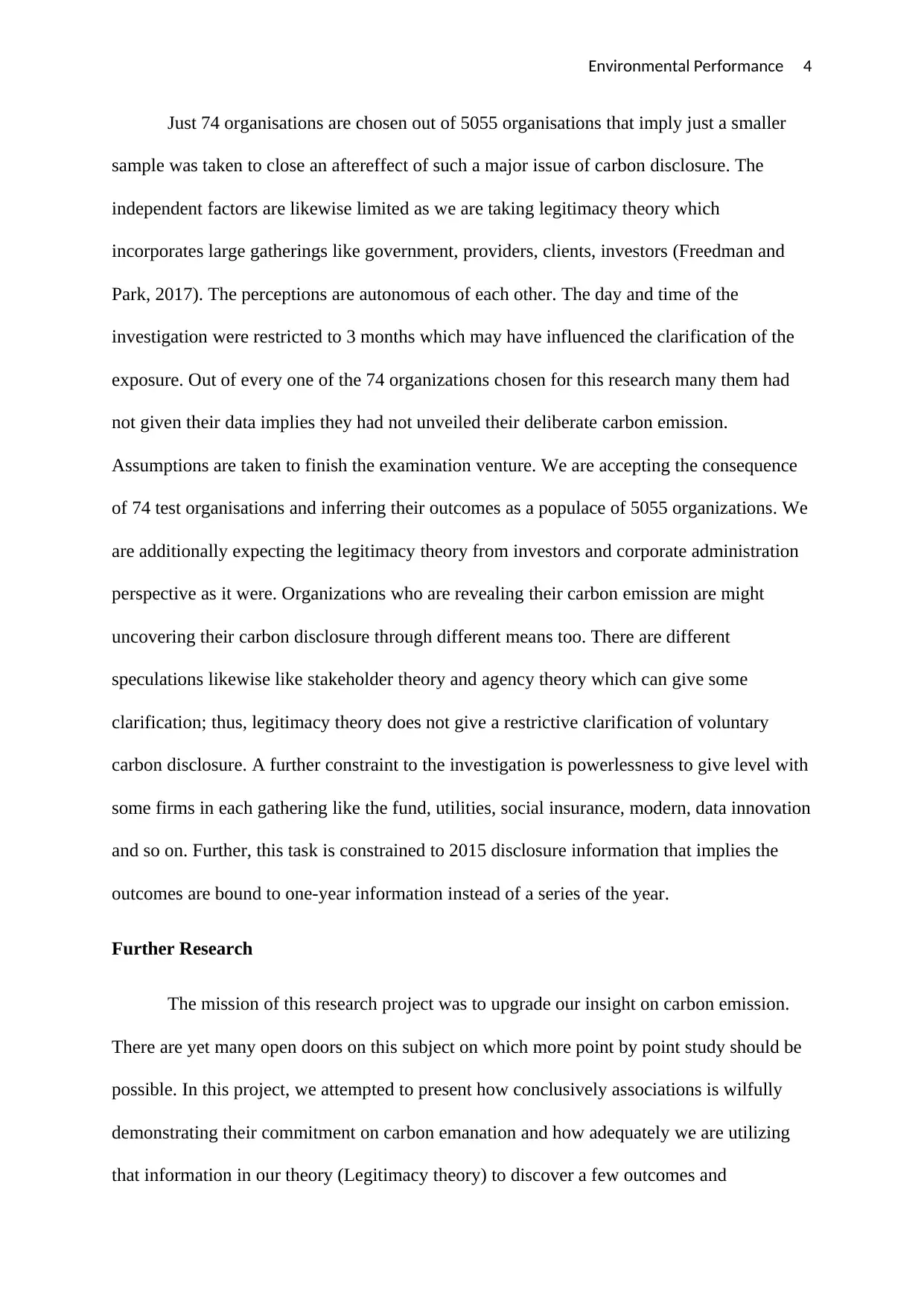
Environmental Performance 4
Just 74 organisations are chosen out of 5055 organisations that imply just a smaller
sample was taken to close an aftereffect of such a major issue of carbon disclosure. The
independent factors are likewise limited as we are taking legitimacy theory which
incorporates large gatherings like government, providers, clients, investors (Freedman and
Park, 2017). The perceptions are autonomous of each other. The day and time of the
investigation were restricted to 3 months which may have influenced the clarification of the
exposure. Out of every one of the 74 organizations chosen for this research many them had
not given their data implies they had not unveiled their deliberate carbon emission.
Assumptions are taken to finish the examination venture. We are accepting the consequence
of 74 test organisations and inferring their outcomes as a populace of 5055 organizations. We
are additionally expecting the legitimacy theory from investors and corporate administration
perspective as it were. Organizations who are revealing their carbon emission are might
uncovering their carbon disclosure through different means too. There are different
speculations likewise like stakeholder theory and agency theory which can give some
clarification; thus, legitimacy theory does not give a restrictive clarification of voluntary
carbon disclosure. A further constraint to the investigation is powerlessness to give level with
some firms in each gathering like the fund, utilities, social insurance, modern, data innovation
and so on. Further, this task is constrained to 2015 disclosure information that implies the
outcomes are bound to one-year information instead of a series of the year.
Further Research
The mission of this research project was to upgrade our insight on carbon emission.
There are yet many open doors on this subject on which more point by point study should be
possible. In this project, we attempted to present how conclusively associations is wilfully
demonstrating their commitment on carbon emanation and how adequately we are utilizing
that information in our theory (Legitimacy theory) to discover a few outcomes and
Just 74 organisations are chosen out of 5055 organisations that imply just a smaller
sample was taken to close an aftereffect of such a major issue of carbon disclosure. The
independent factors are likewise limited as we are taking legitimacy theory which
incorporates large gatherings like government, providers, clients, investors (Freedman and
Park, 2017). The perceptions are autonomous of each other. The day and time of the
investigation were restricted to 3 months which may have influenced the clarification of the
exposure. Out of every one of the 74 organizations chosen for this research many them had
not given their data implies they had not unveiled their deliberate carbon emission.
Assumptions are taken to finish the examination venture. We are accepting the consequence
of 74 test organisations and inferring their outcomes as a populace of 5055 organizations. We
are additionally expecting the legitimacy theory from investors and corporate administration
perspective as it were. Organizations who are revealing their carbon emission are might
uncovering their carbon disclosure through different means too. There are different
speculations likewise like stakeholder theory and agency theory which can give some
clarification; thus, legitimacy theory does not give a restrictive clarification of voluntary
carbon disclosure. A further constraint to the investigation is powerlessness to give level with
some firms in each gathering like the fund, utilities, social insurance, modern, data innovation
and so on. Further, this task is constrained to 2015 disclosure information that implies the
outcomes are bound to one-year information instead of a series of the year.
Further Research
The mission of this research project was to upgrade our insight on carbon emission.
There are yet many open doors on this subject on which more point by point study should be
possible. In this project, we attempted to present how conclusively associations is wilfully
demonstrating their commitment on carbon emanation and how adequately we are utilizing
that information in our theory (Legitimacy theory) to discover a few outcomes and
Paraphrase This Document
Need a fresh take? Get an instant paraphrase of this document with our AI Paraphraser
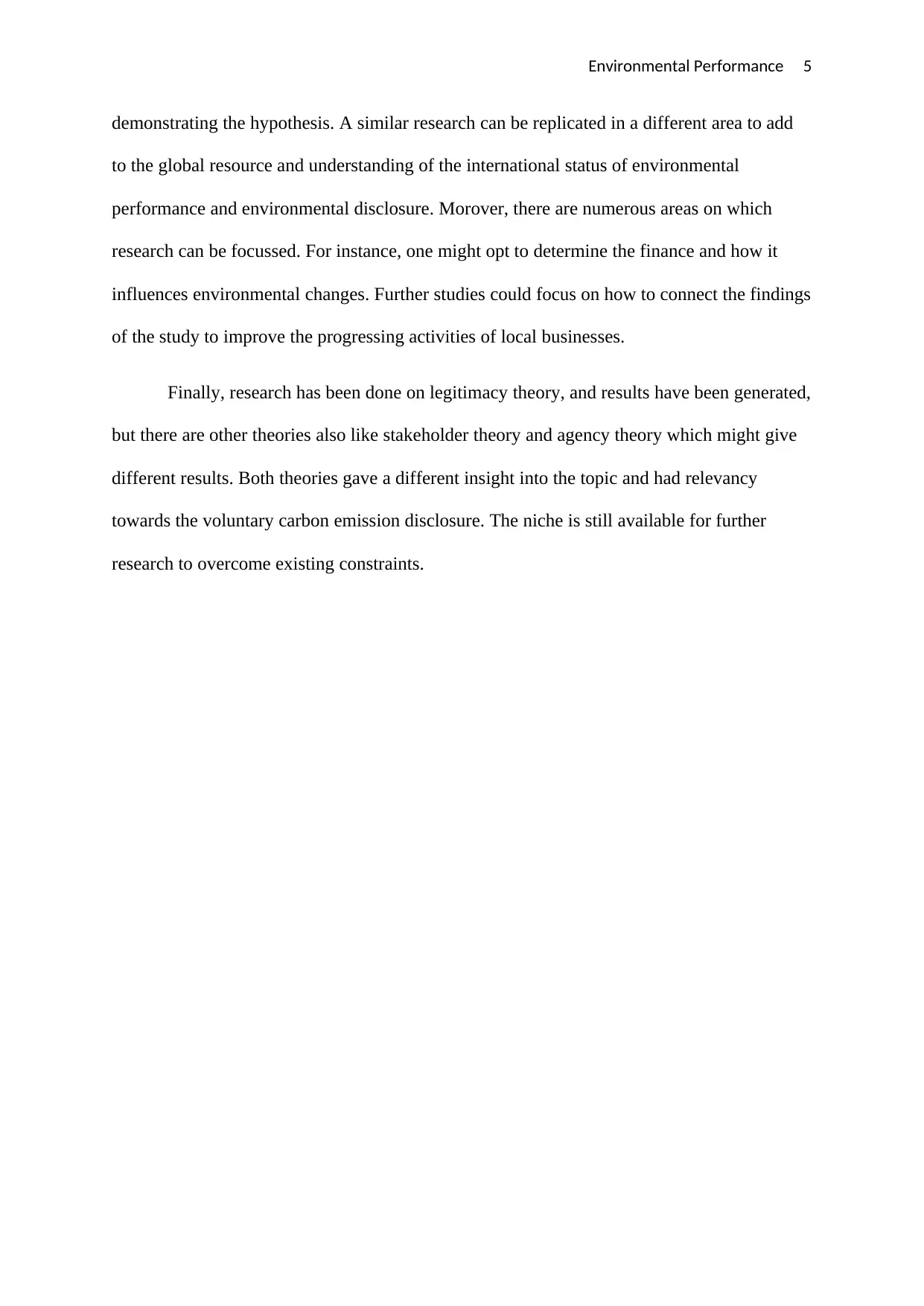
Environmental Performance 5
demonstrating the hypothesis. A similar research can be replicated in a different area to add
to the global resource and understanding of the international status of environmental
performance and environmental disclosure. Morover, there are numerous areas on which
research can be focussed. For instance, one might opt to determine the finance and how it
influences environmental changes. Further studies could focus on how to connect the findings
of the study to improve the progressing activities of local businesses.
Finally, research has been done on legitimacy theory, and results have been generated,
but there are other theories also like stakeholder theory and agency theory which might give
different results. Both theories gave a different insight into the topic and had relevancy
towards the voluntary carbon emission disclosure. The niche is still available for further
research to overcome existing constraints.
demonstrating the hypothesis. A similar research can be replicated in a different area to add
to the global resource and understanding of the international status of environmental
performance and environmental disclosure. Morover, there are numerous areas on which
research can be focussed. For instance, one might opt to determine the finance and how it
influences environmental changes. Further studies could focus on how to connect the findings
of the study to improve the progressing activities of local businesses.
Finally, research has been done on legitimacy theory, and results have been generated,
but there are other theories also like stakeholder theory and agency theory which might give
different results. Both theories gave a different insight into the topic and had relevancy
towards the voluntary carbon emission disclosure. The niche is still available for further
research to overcome existing constraints.
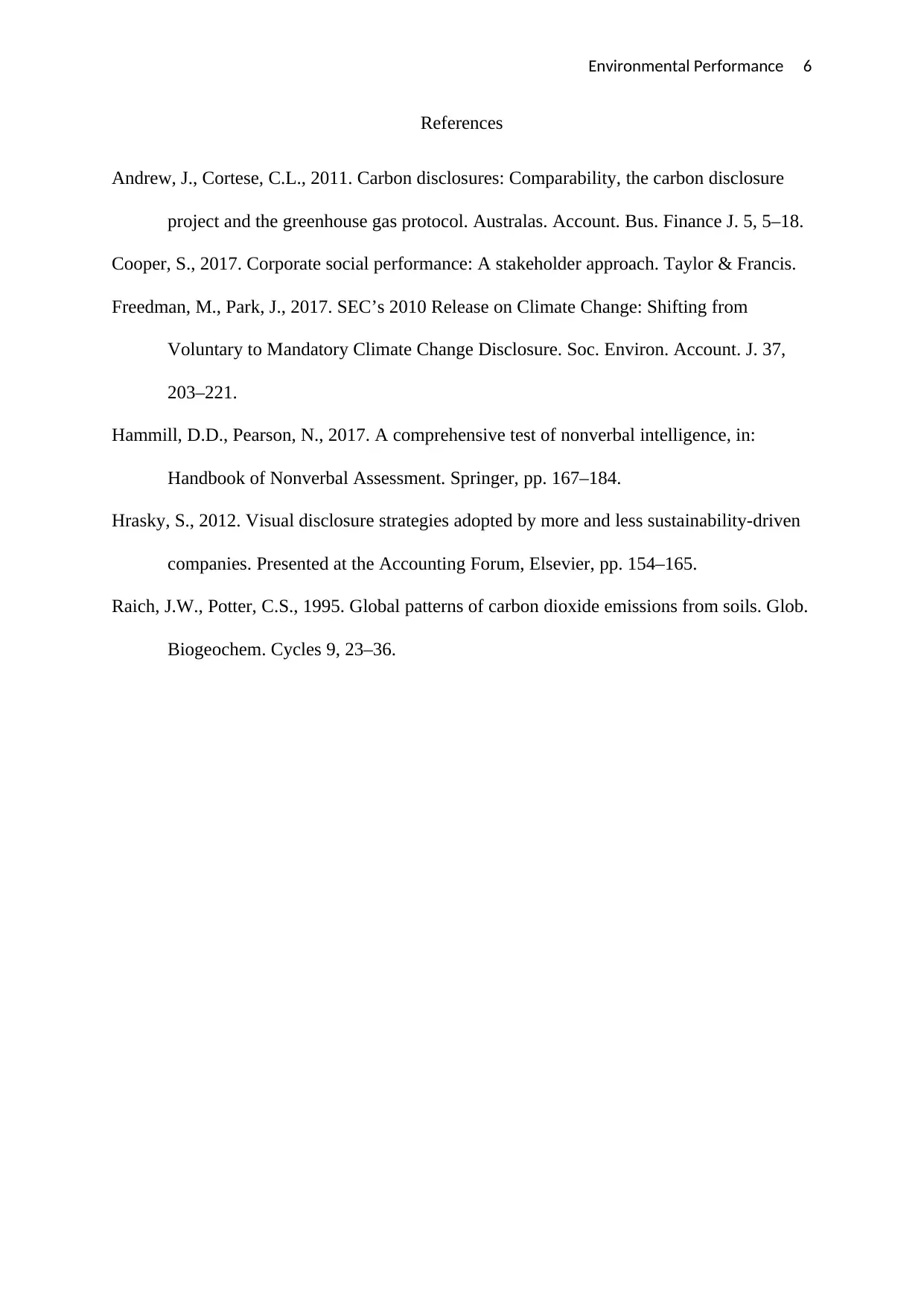
Environmental Performance 6
References
Andrew, J., Cortese, C.L., 2011. Carbon disclosures: Comparability, the carbon disclosure
project and the greenhouse gas protocol. Australas. Account. Bus. Finance J. 5, 5–18.
Cooper, S., 2017. Corporate social performance: A stakeholder approach. Taylor & Francis.
Freedman, M., Park, J., 2017. SEC’s 2010 Release on Climate Change: Shifting from
Voluntary to Mandatory Climate Change Disclosure. Soc. Environ. Account. J. 37,
203–221.
Hammill, D.D., Pearson, N., 2017. A comprehensive test of nonverbal intelligence, in:
Handbook of Nonverbal Assessment. Springer, pp. 167–184.
Hrasky, S., 2012. Visual disclosure strategies adopted by more and less sustainability-driven
companies. Presented at the Accounting Forum, Elsevier, pp. 154–165.
Raich, J.W., Potter, C.S., 1995. Global patterns of carbon dioxide emissions from soils. Glob.
Biogeochem. Cycles 9, 23–36.
References
Andrew, J., Cortese, C.L., 2011. Carbon disclosures: Comparability, the carbon disclosure
project and the greenhouse gas protocol. Australas. Account. Bus. Finance J. 5, 5–18.
Cooper, S., 2017. Corporate social performance: A stakeholder approach. Taylor & Francis.
Freedman, M., Park, J., 2017. SEC’s 2010 Release on Climate Change: Shifting from
Voluntary to Mandatory Climate Change Disclosure. Soc. Environ. Account. J. 37,
203–221.
Hammill, D.D., Pearson, N., 2017. A comprehensive test of nonverbal intelligence, in:
Handbook of Nonverbal Assessment. Springer, pp. 167–184.
Hrasky, S., 2012. Visual disclosure strategies adopted by more and less sustainability-driven
companies. Presented at the Accounting Forum, Elsevier, pp. 154–165.
Raich, J.W., Potter, C.S., 1995. Global patterns of carbon dioxide emissions from soils. Glob.
Biogeochem. Cycles 9, 23–36.
⊘ This is a preview!⊘
Do you want full access?
Subscribe today to unlock all pages.

Trusted by 1+ million students worldwide
1 out of 6
Related Documents
Your All-in-One AI-Powered Toolkit for Academic Success.
+13062052269
info@desklib.com
Available 24*7 on WhatsApp / Email
![[object Object]](/_next/static/media/star-bottom.7253800d.svg)
Unlock your academic potential
Copyright © 2020–2025 A2Z Services. All Rights Reserved. Developed and managed by ZUCOL.




